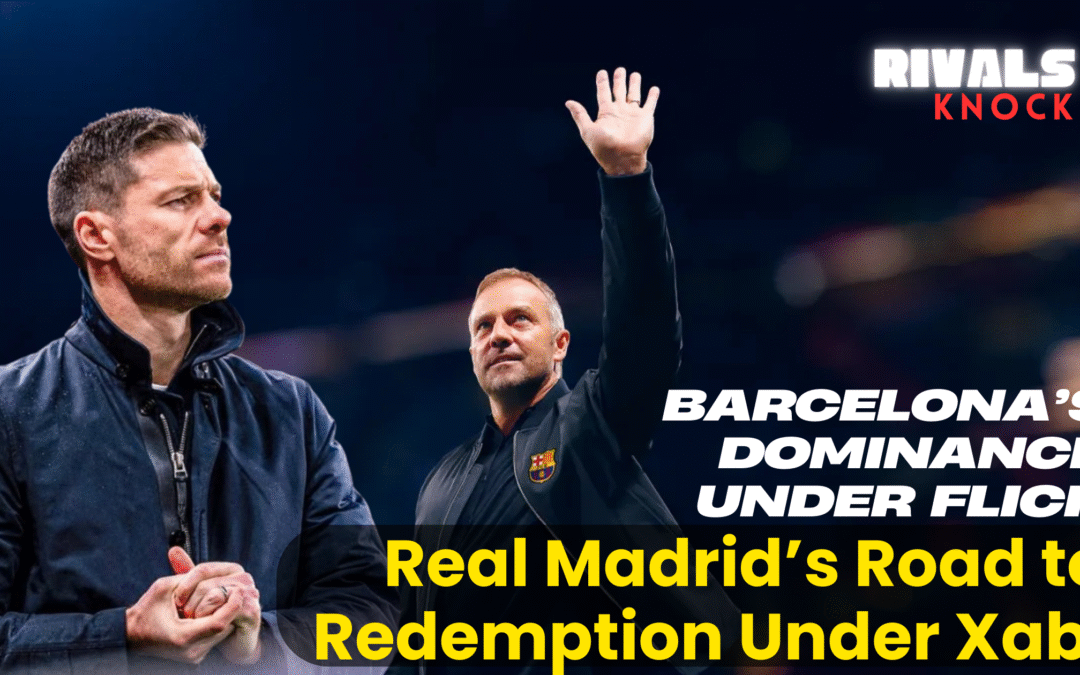May 20, 2025. The Santiago Bernabéu isn’t just quiet—it’s hurting. A place that breathes pride now sits heavy with silence after a nightmare season of El Clásico beatdowns. Four brutal losses—4-0, 5-2, 3-2, and that crushing 4-3 defeat on May 11—left Real Madrid scarred, the scoreboard reading a painful 16-7 over the season.
Barcelona didn’t just win—they dominated. Hansi Flick’s high-pressing setup ran Madrid into the ground. Lamine Yamal, now widely seen as the best young talent in the world, danced through defenses, and with those wins, Barça lifted both La Liga and Copa del Rey.
Ancelotti’s era ended in embarrassment. Now, Xabi Alonso walks into the fire. Fresh off a historic run with Bayer Leverkusen, he brings hope, fresh faces, and a new style of football. With a revamped backline featuring Trent Alexander-Arnold, Dean Huijsen, and Álvaro Carreras, Alonso’s Madrid is ready to fight back.
Can Alonso’s possession game break Barcelona’s pressing storm? Or will the Catalan giants continue to roar?
Flick vs. Alonso – A Tactical War
Imagine the Bernabeu roaring under the lights. It’s El Clásico night again, and Hansi Flick’s Barcelona shows no signs of slowing. His 4-3-3 machine presses with hunger—averaging 12 recoveries a game and owning 62% of the ball. Lamine Yamal, averaging 3.5 dribbles per match, cuts in from the right. Alejandro Balde flies forward from left-back, linking with Frenkie de Jong, who delivers 3.1 key passes per game.
Last season, Real Madrid’s defense collapsed under this pressure, conceding 16 goals in just four meetings.
But this season is different. Alonso’s 3-2-4-1 formation—built on his Leverkusen blueprint—is bold. On the ball, it transforms into a 3-2-5 with Huijsen, Militão, and Rüdiger building from the back. Tchouameni and Valverde form a double shield in midfield, while Trent pushes high to stretch play.
The plan? Break the press with sharp passes and fluid movement. Huijsen’s long balls (7.5 per game, 62% success) are key, with Bellingham dropping deep and Mbappé making explosive runs forward.
Without the ball, Real presses with a 5-2-3 high line, trying to pin Barcelona wide. But Trent’s defending—often shaky against fast wingers—might be the weak link. Can Alonso’s structure handle the pressure? Or will Flick’s intensity win again?
Heroes & Question Marks
Kylian Mbappé leads the line with 24 La Liga goals. His speed and positioning (0.8 xG per 90) are a nightmare for young Pau Cubarsí. Behind him, Jude Bellingham controls the tempo, winning 65% of his duels and linking brilliantly with Trent’s deadly crosses.
Speaking of Trent—his creativity from right-back is unmatched, but his defending remains a risk. Raphinha, who’s scored twice in El Clásicos, will test him again.
Dean Huijsen, only 19, brings strength and accuracy to Madrid’s backline—10 defensive actions per game and an 87% pass completion. But can he keep up with someone as sharp as Yamal?
Barcelona’s key? Lamine Yamal. Eight assists, a constant threat, and still only a teenager. Alejandro Balde adds width and pace, while Frenkie de Jong’s leadership and passing (3.1 key passes per game) keeps everything ticking.
The game may come down to moments: Mbappé’s power vs. Yamal’s magic. And maybe—just maybe—who handles the pressure better: the rising stars, or the seasoned names?
A History Written in Fire
El Clásico isn’t a game—it’s a legacy. From Ronaldo’s thunderous 2010 header to Messi’s last-second winner in 2017, this rivalry lives in the heart of football history.
But last season? It was all Barça. Four straight wins. A 16-7 aggregate. Their 4-3 win on May 11 was more than just three points—it was a statement.
Madrid’s defense was torn apart. Yamal and Raphinha ran riot. Ancelotti’s gameplan collapsed.
Now comes a new chapter. Xabi Alonso brings change. His possession-based system is designed to fight fire with calm—controlling the ball instead of chasing it. Trent’s arrival adds creativity, but also risk. Against a young, hungry Barça side, any weakness will be punished.
This will not just be a football match, it will be a fight for pride. A battle between two ideas. Can Madrid flip the script, or will Barcelona keep writing their own story?
Xabi’s Redemption Plan: Can Real Madrid Rise Again?
Alonso’s Madrid is a team in transition, built on belief. His 3-2-4-1 system reflects the same ideas that made Bayer Leverkusen fly—ball control, high pressing, and bold attacking.
With Trent (one of Europe’s best passers) now at the club, the team has new width. His crosses aim for Mbappé and Vinicius Jr., who scored 11 last season. Dean Huijsen adds strength at the back, though his agility could be tested again by Yamal.
Álvaro Carreras, full of energy, gives Madrid a much-needed option on the left. But the midfield? That’s the real worry. Luka Modrić, now 40, can’t fill Toni Kroos’ boots. Kroos’ calm control and 92% pass accuracy are sorely missed.
Targets like Florian Wirtz may be heading to Manchester City. Without a top-tier creator in midfield, Alonso’s side could struggle under Barcelona’s relentless press.
Madrid fans are hopeful, but cautious. The ideas are fresh, the belief is back—but Barcelona are still the team to beat.
Final Whistle: Let the Rivalry Burn Again
Barcelona ruled 2024/25. Four wins, 16 goals, total control. Real Madrid were humbled.
But now there’s a fire in the Bernabéu again. Xabi Alonso is here. His new tactics, his new signings—this could be the start of something special.
But anything can happen. Can Alonso’s Madrid take control? Or will Flick’s Barcelona keep the crown?
Tell us what you think. Drop your predictions below and join the #ElClasico conversation on X.
This is war. This is history. This is Rivals Knock.

